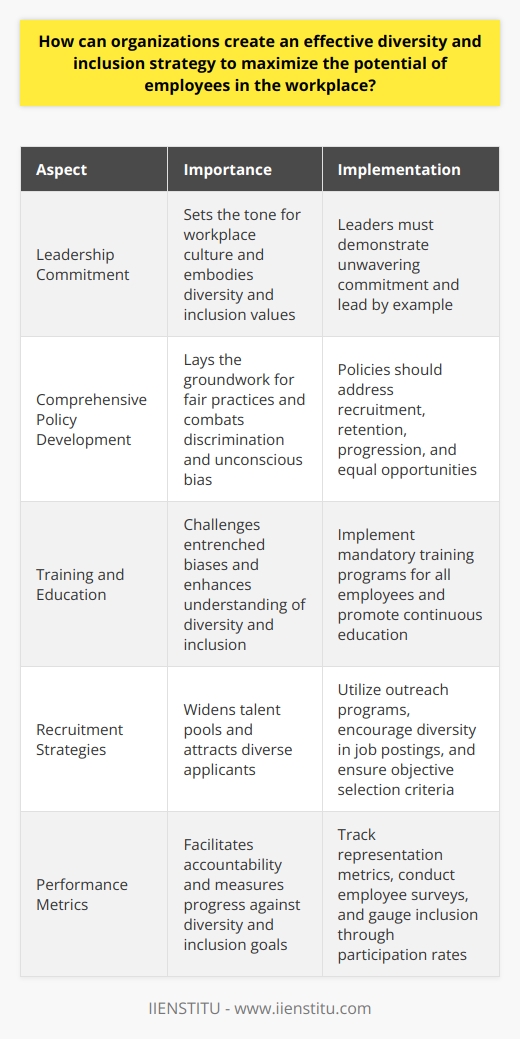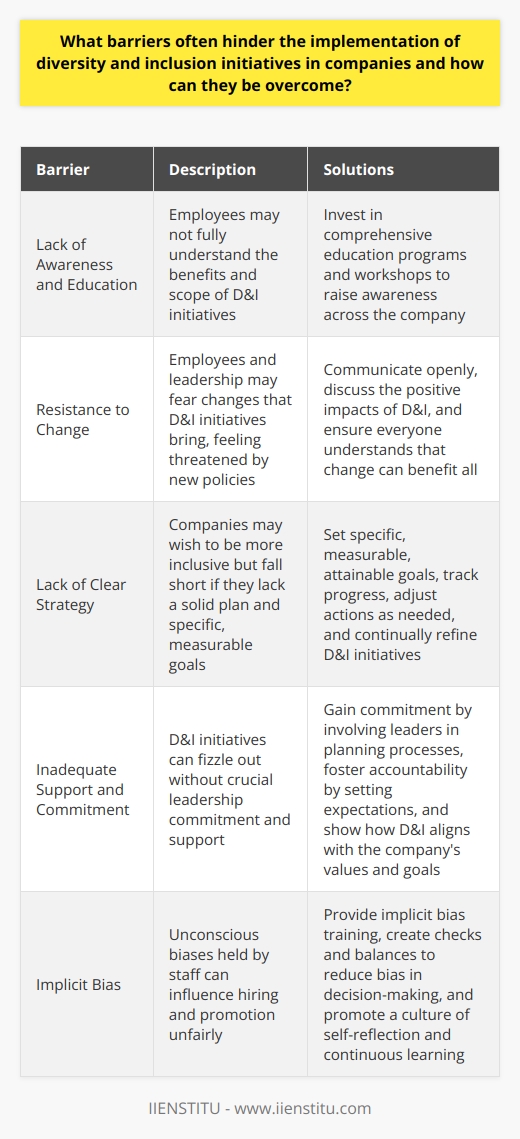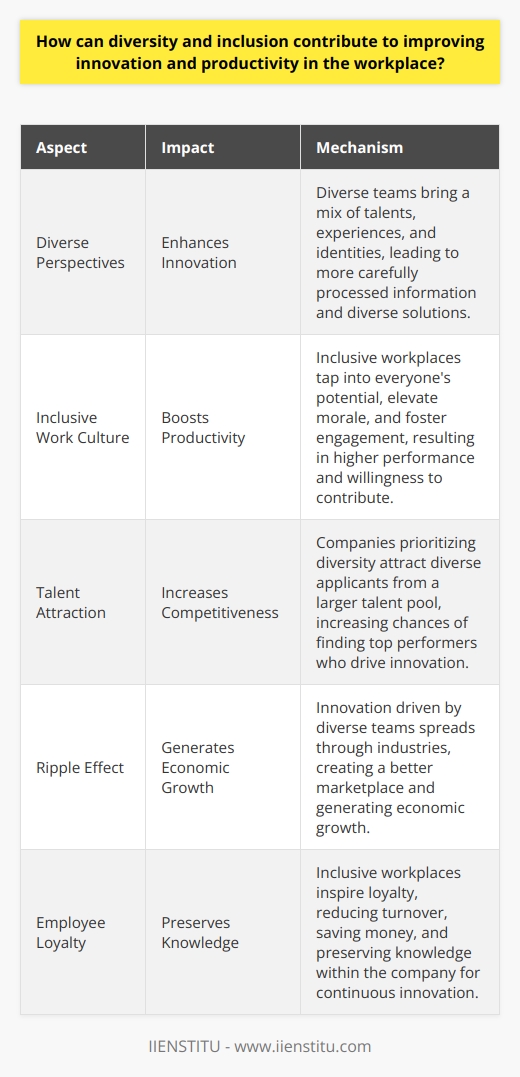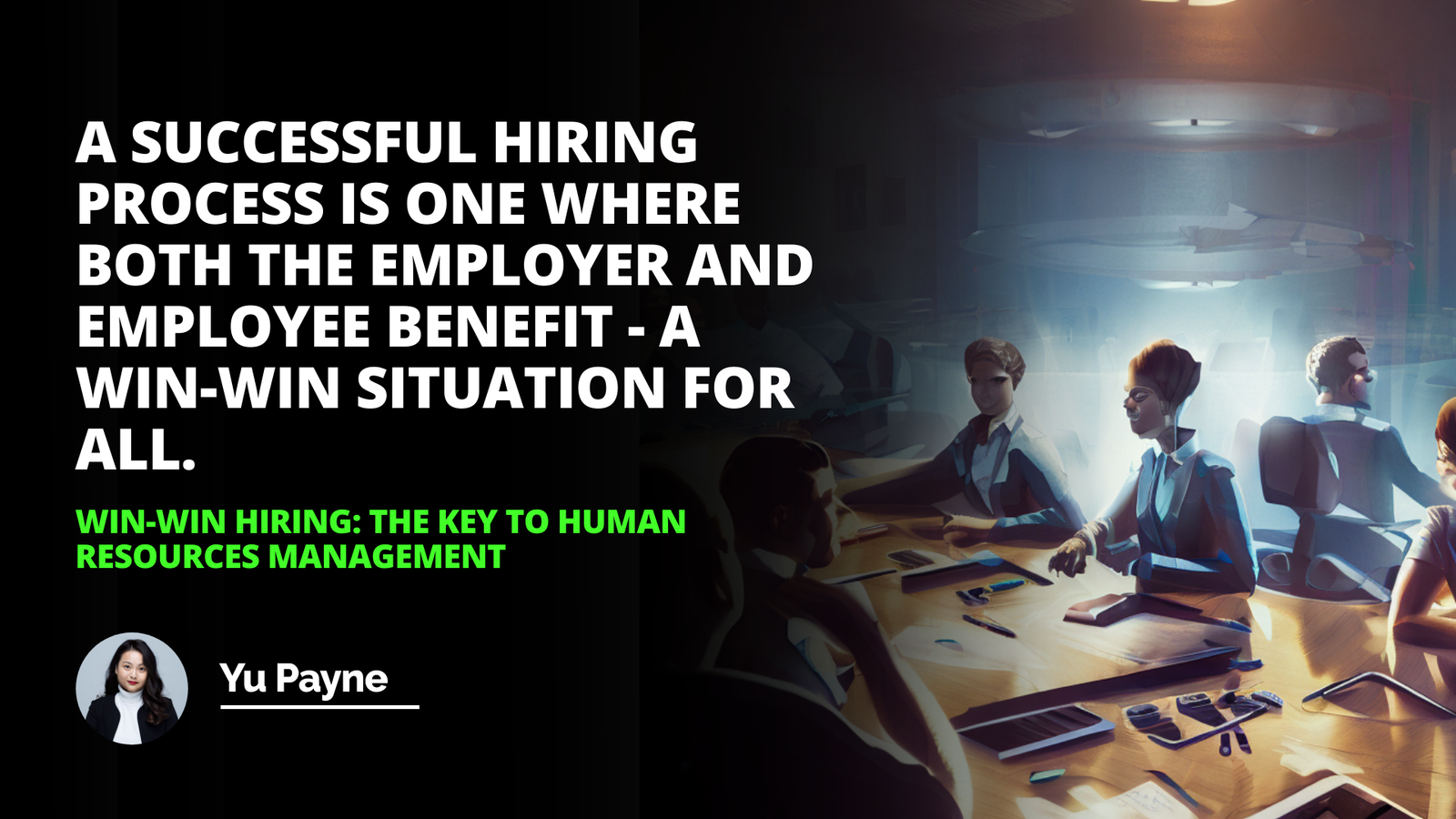
In today's global economy, the importance of diversity and inclusion in the workplace cannot be overstated. As organizations strive to remain competitive and innovative, they must recognize the value of fostering a diverse and inclusive work environment. The role of human resources (HR) in promoting diversity and inclusion is crucial, as it sets the tone for the entire organization. By implementing effective strategies and best practices, HR can help create a culture where all employees feel valued, respected, and empowered to reach their full potential.
Understanding the Importance of Diversity and Inclusion
Diversity refers to the various characteristics that make individuals unique, such as race, gender, age, ethnicity, religion, sexual orientation, and disability status. Inclusion, on the other hand, is about creating an environment where all individuals feel welcomed, respected, and valued for their contributions. When combined, diversity and inclusion can lead to numerous benefits for organizations, including:
1- Increased Innovation and Creativity: A diverse workforce brings together individuals with different perspectives, experiences, and ideas. This diversity of thought can lead to more creative problem-solving and innovative solutions. According to a study by McKinsey & Company, companies in the top quartile for racial and ethnic diversity are 35% more likely to have financial returns above their respective national industry medians (Hunt et al., 2018).
2- Improved Employee Engagement and Retention: When employees feel included and valued, they are more likely to be engaged and committed to their work. This can lead to higher job satisfaction, lower turnover rates, and increased productivity. A study by Deloitte found that inclusive teams outperform their peers by 80% in team-based assessments (Smith & Turner, 2015).
3- Enhanced Reputation and Brand Image: Companies that prioritize diversity and inclusion are often seen as more socially responsible and attractive to customers and job seekers. A diverse workforce can also help organizations better understand and serve diverse customer needs. A survey by Glassdoor found that 67% of job seekers consider diversity an important factor when evaluating companies and job offers (Glassdoor, 2020).
Best Practices for Measuring Inclusion in the Workplace
Measuring inclusion in the workplace is essential for understanding the effectiveness of diversity and inclusion initiatives and identifying areas for improvement. Some best practices for measuring inclusion include:
1- Employee Surveys: Conducting regular employee surveys can provide valuable insights into how employees perceive the level of inclusion in the workplace. These surveys should include questions related to fairness, respect, belonging, and opportunities for growth and development. The results can be used to identify trends and track progress over time.
2- Diversity Metrics: Tracking diversity metrics, such as the representation of different demographic groups at various levels of the organization, can help identify gaps and opportunities for improvement. This data should be regularly reviewed and analyzed to ensure that diversity and inclusion goals are being met.
3- Employee Resource Groups (ERGs): ERGs are voluntary, employee-led groups that bring together individuals with common backgrounds or interests. These groups can provide valuable feedback on the effectiveness of inclusion initiatives and help identify areas for improvement. ERGs can also serve as a support network for employees and help foster a sense of belonging.
4- Exit Interviews: Conducting exit interviews with employees who are leaving the organization can provide valuable insights into the reasons behind their departure. If issues related to diversity and inclusion are identified, this information can be used to make necessary changes and improvements.
How to Implement Unconscious Bias Training in HR
Unconscious bias refers to the automatic, mental shortcuts that individuals use to process information and make decisions. These biases can lead to unfair treatment and discrimination in the workplace, even when individuals are not aware of them. Implementing unconscious bias training in HR can help raise awareness of these biases and provide strategies for overcoming them. Some steps for implementing unconscious bias training include:
1- Identify Training Needs: Conduct an assessment of the organization's current level of awareness and understanding of unconscious bias. This can be done through employee surveys, focus groups, or interviews with key stakeholders.
2- Develop Training Content: Work with diversity and inclusion experts to develop training content that is relevant, engaging, and effective. The content should cover topics such as the types of unconscious bias, how they manifest in the workplace, and strategies for overcoming them.
3- Deliver Training: Provide training to all employees, including leadership and HR staff. The training should be mandatory and delivered in a format that is accessible and convenient for all employees. Consider offering both in-person and online training options to accommodate different learning styles and schedules.
4- Evaluate Effectiveness: Evaluate the effectiveness of the training by conducting post-training surveys or assessments. Use this feedback to make necessary improvements and adjustments to the training content and delivery.
5- Provide Ongoing Support: Provide ongoing support and resources to help employees apply the skills and knowledge gained from the training. This can include regular refresher courses, coaching, and mentoring programs.
Top Diversity Recruitment Strategies for Companies
Recruiting a diverse workforce requires intentional and strategic efforts. Some top diversity recruitment strategies for companies include:
1- Expand Recruitment Channels: Look beyond traditional recruitment channels and actively seek out candidates from underrepresented groups. This can include partnering with diversity-focused organizations, attending diversity job fairs, and leveraging employee referral programs.
2- Use Inclusive Language in Job Descriptions: Review job descriptions to ensure that they use inclusive language and avoid bias. This can include using gender-neutral language, avoiding jargon or industry-specific terms, and highlighting the company's commitment to diversity and inclusion.
3- Implement Blind Hiring Practices: Consider implementing blind hiring practices, such as removing names and other identifying information from resumes, to reduce the potential for bias in the initial screening process.
4- Provide Diversity and Inclusion Training for Interviewers: Provide training for interviewers on how to conduct fair and unbiased interviews. This can include training on how to ask appropriate questions, avoid making assumptions, and evaluate candidates based on their qualifications and skills.
5- Establish Diversity Hiring Goals: Set specific, measurable diversity hiring goals and track progress towards these goals. This can help ensure that diversity and inclusion remain a priority throughout the recruitment process.
Examples of Successful Corporate Inclusion Initiatives
Many companies have implemented successful inclusion initiatives that have led to positive outcomes for both employees and the organization as a whole. Some examples include:
1- Salesforce: Salesforce has implemented a comprehensive diversity and inclusion program that includes employee resource groups, unconscious bias training, and a focus on inclusive leadership. The company has also set ambitious diversity hiring goals and regularly reports on its progress towards these goals.
2- Accenture: Accenture has implemented a global diversity and inclusion program that includes employee resource groups, mentoring programs, and a focus on inclusive leadership. The company has also set a goal of achieving a gender-balanced workforce by 2025.
3- Microsoft: Microsoft has implemented a range of diversity and inclusion initiatives, including employee resource groups, unconscious bias training, and a focus on accessible technology. The company has also set ambitious diversity hiring goals and regularly reports on its progress towards these goals.
How to Create an Inclusive Company Culture Step-by-Step
Creating an inclusive company culture requires a strategic and intentional approach. Some steps for creating an inclusive company culture include:
1- Define Inclusion: Clearly define what inclusion means for your organization and communicate this definition to all employees. This can include developing a diversity and inclusion statement that outlines the company's commitment to creating an inclusive workplace.
2- Assess Current Culture: Conduct an assessment of the organization's current culture to identify areas for improvement. This can include employee surveys, focus groups, and interviews with key stakeholders.
3- Develop an Action Plan: Based on the results of the assessment, develop an action plan that outlines specific steps for creating a more inclusive culture. This can include initiatives such as implementing diversity and inclusion training, establishing employee resource groups, and reviewing policies and procedures for bias.
4- Engage Leadership: Engage leadership in the process of creating an inclusive culture. This can include providing training and resources for leaders on how to model inclusive behaviors and create an inclusive environment for their teams.
5- Communicate Regularly: Communicate regularly with employees about the organization's diversity and inclusion efforts. This can include sharing progress updates, highlighting successes, and soliciting feedback and input from employees.
6- Measure Progress: Measure progress towards creating an inclusive culture by tracking key metrics such as employee engagement, retention, and representation of underrepresented groups. Use this data to continuously improve and refine diversity and inclusion efforts.
Ways to Enhance Employee Engagement Through Diversity Programs
Diversity programs can be a powerful tool for enhancing employee engagement and creating a more inclusive workplace. Some ways to enhance employee engagement through diversity programs include:
1- Encourage Employee Participation: Encourage employees to participate in diversity programs and initiatives. This can include inviting employees to join employee resource groups, attend diversity and inclusion events, and provide feedback and input on diversity and inclusion efforts.
2- Provide Opportunities for Learning and Development: Provide opportunities for employees to learn about diversity and inclusion through training, workshops, and other educational resources. This can help employees develop a deeper understanding of the importance of diversity and inclusion and how they can contribute to creating a more inclusive workplace.
3- Recognize and Reward Inclusive Behaviors: Recognize and reward employees who demonstrate inclusive behaviors and contribute to creating a more inclusive workplace. This can include highlighting success stories, providing incentives for participation in diversity programs, and incorporating diversity and inclusion into performance evaluations.
4- Foster Open Communication: Foster open communication and encourage employees to share their experiences, perspectives, and ideas related to diversity and inclusion. This can include hosting regular town hall meetings, conducting employee surveys, and providing opportunities for employees to provide feedback and input on diversity and inclusion efforts.
Measuring ROI for Diversity and Inclusion Initiatives
Measuring the return on investment (ROI) for diversity and inclusion initiatives can be challenging, but it is essential for demonstrating the value of these efforts to the organization. Some ways to measure ROI for diversity and inclusion initiatives include:
1- Track Recruitment and Retention Metrics: Track recruitment and retention metrics, such as the number of diverse candidates hired, the retention rate of diverse employees, and the representation of underrepresented groups at various levels of the organization. Improvements in these metrics can indicate a positive ROI for diversity and inclusion initiatives.
2- Measure Employee Engagement: Measure employee engagement through surveys, focus groups, and other feedback mechanisms. Improved employee engagement can be a strong indicator of the effectiveness of diversity and inclusion initiatives.
3- Assess Business Outcomes: Assess the impact of diversity and inclusion initiatives on business outcomes, such as revenue, profitability, and customer satisfaction. Research has shown that companies with more diverse workforces tend to have better financial performance (Hunt et al., 2018).
4- Calculate Cost Savings: Calculate cost savings associated with diversity and inclusion initiatives, such as reduced turnover, improved productivity, and reduced legal costs associated with discrimination claims.
Dealing with Unconscious Bias in Recruitment and Hiring
Unconscious bias can have a significant impact on recruitment and hiring decisions, leading to unfair treatment and discrimination against underrepresented groups. Some strategies for dealing with unconscious bias in recruitment and hiring include:
1- Provide Training: Provide training for recruiters, hiring managers, and interviewers on how to recognize and overcome unconscious bias. This can include training on how to use objective criteria for evaluating candidates, avoid making assumptions based on stereotypes, and create a fair and inclusive hiring process.
2- Use Structured Interviews: Use structured interviews that ask the same questions of all candidates and evaluate responses based on predetermined criteria. This can help reduce the potential for bias and ensure that all candidates are evaluated fairly and consistently.
3- Implement Blind Hiring Practices: Implement blind hiring practices, such as removing names and other identifying information from resumes, to reduce the potential for bias in the initial screening process.
4- Diversify Interview Panels: Diversify interview panels to include individuals from different backgrounds and perspectives. This can help reduce the potential for bias and ensure that candidates are evaluated from multiple perspectives.
5- Monitor Hiring Data: Monitor hiring data to identify any patterns or trends that may indicate the presence of unconscious bias. Use this data to continuously improve and refine recruitment and hiring processes to ensure fairness and equity.
Real-Life Case Studies of Inclusive Organizations
1- Procter & Gamble: Procter & Gamble (P&G) has made significant strides in creating a more diverse and inclusive workplace. The company has implemented a range of initiatives, including employee resource groups, mentoring programs, and a focus on inclusive leadership. P&G has also set ambitious diversity hiring goals and regularly reports on its progress towards these goals. As a result of these efforts, P&G has been recognized as one of the most diverse and inclusive companies in the world (P&G, 2021).
2- Accenture: Accenture has implemented a comprehensive diversity and inclusion program that includes employee resource groups, mentoring programs, and a focus on inclusive leadership. The company has also set a goal of achieving a gender-balanced workforce by 2025. As a result of these efforts, Accenture has seen significant improvements in employee engagement, retention, and business outcomes (Accenture, 2021).
3- Salesforce: Salesforce has made diversity and inclusion a key priority, implementing a range of initiatives such as employee resource groups, unconscious bias training, and a focus on inclusive leadership. The company has also set ambitious diversity hiring goals and regularly reports on its progress towards these goals. As a result of these efforts, Salesforce has been recognized as one of the most inclusive companies in the technology industry (Salesforce, 2021).
In conclusion, the importance of HR diversity and inclusion for business success cannot be overstated. By implementing best practices for measuring inclusion, providing unconscious bias training, and developing effective diversity recruitment strategies, companies can create a more inclusive and equitable workplace culture. Successful corporate inclusion initiatives, such as those implemented by Procter & Gamble, Accenture, and Salesforce, demonstrate the positive impact that these efforts can have on employee engagement, retention, and business outcomes. As organizations continue to prioritize diversity and inclusion, it is essential to measure the ROI of these initiatives and continuously refine and improve approaches to ensure ongoing success.
References:
Accenture. (2021). Inclusion and Diversity at Accenture. https://www.accenture.com/us-en/about/inclusion-diversity/us-workforce
Glassdoor. (2020). Diversity & Inclusion Workplace Survey. https://www.glassdoor.com/blog/glassdoors-diversity-and-inclusion-workplace-survey/
Hunt, V., Prince, S., Dixon-Fyle, S., & Yee, L. (2018). Delivering through Diversity. McKinsey & Company. https://www.mckinsey.com/business-functions/organization/our-insights/delivering-through-diversity
P&G. (2021). Diversity & Inclusion at P&G. https://us.pg.com/diversity-and-inclusion/
Salesforce. (2021). Equality at Salesforce. https://www.salesforce.com/company/equality/
Smith, C., & Turner, S. (2015). The Radical Transformation of Diversity and Inclusion: The Millennial Influence. Deloitte University Leadership Center for Inclusion. https://www2.deloitte.com/content/dam/Deloitte/us/Documents/about-deloitte/us-inclus-millennial-influence-120215.pdf
Frequently Asked Questions
How can organizations create an effective diversity and inclusion strategy to maximize the potential of employees in the workplace?
Understanding Diversity and Inclusion
Organizations often grapple with diversity and inclusion. They see its potential. Diverse viewpoints fuel creativity and innovation. Inclusion fosters employee engagement and satisfaction. Yet, many struggle to harness these benefits.
Defining Objectives
Strategies start with clear objectives. Leaders must identify what they aim to achieve. Are they increasing workforce diversity? Are they creating a more inclusive culture? Specific, measurable, achievable, relevant, and time-bound (SMART) goals are crucial.
Leadership Commitment
Leadership plays a critical role. They must demonstrate unwavering commitment. This permeates organizational ethos effectively. Leaders set the tone for workplace culture. They should embody diversity and inclusion values.
Comprehensive Policy Development
Policies must reflect diversity goals. They should address recruitment, retention, and progression. Equal opportunities lie at their heart. Policies should combat discrimination and unconscious bias. They lay the groundwork for fair practices.
Training and Education
Education is fundamental to understanding. Diversity training can enlighten staff. It challenges entrenched biases. Mandatory training programs work best. They ensure all employees partake. Continuous education leads to sustained progress.
Recruitment Strategies
Recruitment needs dedicated attention. Organizations should widen talent pools. Outreach programs can attract diverse applicants. Job postings should encourage diversity. Selection criteria must remain objective. This ensures merit-based hiring.
Mentoring and Support Networks
Employees benefit from support. Mentoring can drive their development. It helps unlock their full potential. Support networks provide a sense of belonging. They cater to diverse groups within organizations.
Performance Metrics
Measurement facilitates accountability. Organizations should track progress against goals. Employee surveys can reveal insights. Representation metrics can measure diversity levels. Inclusion can be gauged through employee participation rates.
Regular Review and Adaptation
Strategies must remain dynamic. Regular reviews identify areas for improvement. Feedback loops encourage ongoing adaptation. Listening to employees is critical. Their experiences shed light on strategy effectiveness.
Celebrate Diversity
Celebrations can mark progress. They acknowledge diverse cultures and contributions. This fosters a sense of pride in employees. Recognition can motivate further achievements.
Fostering Open Dialogue
Open dialogue invites various viewpoints. It creates a culture of communication. Employees should feel heard. Regular town halls can facilitate this. They should cover diversity and inclusion updates.
Conclusion
An effective diversity and inclusion strategy requires multifaceted approaches. Clear objectives and policy development are starting points. Training, recruitment, and support systems enhance employee potential. Measurement and adaptation ensure strategies stay relevant. Above all, commitment from leadership drives the long-term success of these initiatives. Celebrating diversity and fostering open dialogue emboldens a culture of inclusiveness. In this environment, employees can truly thrive.

What barriers often hinder the implementation of diversity and inclusion initiatives in companies and how can they be overcome?
Understanding Barriers to Diversity and Inclusion
Implementing diversity and inclusion (D&I) initiatives often meets several barriers. Companies sometimes struggle to create truly inclusive cultures. It's critical to recognize these obstacles. Only then can organizations begin to address them.
Lack of Awareness and Education
Education serves as the foundation for change. A common barrier is the lack of awareness of D&I's benefits. Some employees may not fully grasp what diversity encompasses. It goes beyond race and gender. It includes sexuality, disability, age, and more.
- Break this barrier by investing in comprehensive education programs.
- Workshops can raise awareness across the company.
- Leaders must learn the value D&I adds to the workplace.
Resistance to Change
Change often invites resistance. Employees and leadership may fear changes D&I initiatives bring. They might feel threatened by new policies. They could worry about their positions in the company.
- To overcome this, communicate openly.
- Discuss the positive impacts of D&I.
- Ensure everyone understands that change can benefit all.
Lack of Clear Strategy
Another barrier is a poorly defined D&I strategy. Companies may wish to be more inclusive. Yet they fall short if they lack a solid plan. Goals qualify as unachievable without clear strategies.
- Set specific, measurable, attainable goals.
- Track progress and adjust actions as needed.
- Continually refine your D&I initiatives.
Inadequate Support and Commitment
Sometimes initiatives lack the support they need. Leadership commitment proves crucial for D&I efforts. Without it, initiatives can fizzle out.
- Gain commitment by involving leaders in planning processes.
- Foster accountability by setting expectations.
- Show how D&I aligns with the company's values and goals.
Tokenism
Tokenism acts as a subtle but significant barrier. Companies may recruit diverse candidates simply to meet quotas. This approach can backfire. It often leads to a lack of genuine inclusion.
- Promote authentic inclusion; avoid mere compliance.
- Strive for depth, not just surface-level diversity.
Implicit Bias
Implicit bias remains an unconscious hindrance. Staff may hold biases they're not aware of. These can influence hiring and promotion unfairly.
- Implicit bias training can help.
- Create checks and balances to reduce bias in decision-making.
- Promote a culture of self-reflection and continuous learning.
Insufficient Resources
Resource allocation can represent a barrier. D&I initiatives may require significant investment. Companies might not provide adequate resources.
- Advocate for the required resources fiercely.
- Demonstrate the long-term value of D&I.
Unrealistic Expectations
Finally, organizations might set unrealistic expectations. They can expect quick results from their D&I initiatives. Real change takes time.
- Set realistic timelines.
- Celebrate small wins.
- Stay persistent and patient.
Overcoming Barriers
To overcome these barriers, a multifaceted approach is necessary. Combine strong leadership, clear communication, and thorough training. Dedicate sufficient resources and foster an environment of continuous improvement. Remember that diversity and inclusion are not just targets to meet. They are essential for building a thriving, innovative workplace. Only through persistent effort can these barriers be dismantled, leading to a more equitable and productive corporate environment.

How can diversity and inclusion contribute to improving innovation and productivity in the workplace?
Diversity and Inclusion Enhance Innovation
Diversity brings various perspectives to the table. It seeds innovation through a mix of talents, experiences, and identities. Diverse teams outperform homogenous ones significantly. They often process information more carefully. Respecting individual differences fosters a culture of creativity.
Consider innovation as problem-solving. Diverse thinkings lead to diverse solutions. Teams that are diverse challenge each other more. This constructive conflict fosters better decision-making.
Productivity Grows With Inclusive Work Cultures
Inclusive workplaces tap into everyone's potential. They elevate company morale. Heightened morale boosts productivity. Happy employees work better. They are more engaged. Engagement drives higher performance.
Employees in inclusive environments feel respected. They contribute more willingly. They share ideas more freely.
Inclusive Environments Attract Diverse Talent
Companies that prioritize diversity attract diverse applicants. They select from a larger talent pool. More choices increase the chances of finding top performers. Great talent drives innovation. Innovation improves competitiveness.
The Ripple Effect of Diversity in Business
When companies innovate, industries advance. Other businesses must adapt. Innovation thus spreads. This ripple effect generates economic growth. It creates a better marketplace for everyone.
An inclusive workplace inspires loyalty. Employees stay with such companies longer. Lower turnover saves money. It preserves knowledge within the company. Stability cultivates a strong foundation for continuous innovation.
Final Thoughts: Innovation Through Diversity
Diverse teams mirror diverse consumer markets. They understand customer needs better. They design products that appeal to more people. This expands market reach. It enhances brand reputation.
In conclusion, diversity and inclusion offer tangible benefits. They are not just ethical priorities. They are smart business strategies. They promise a more dynamic, innovative, and productive workforce.



